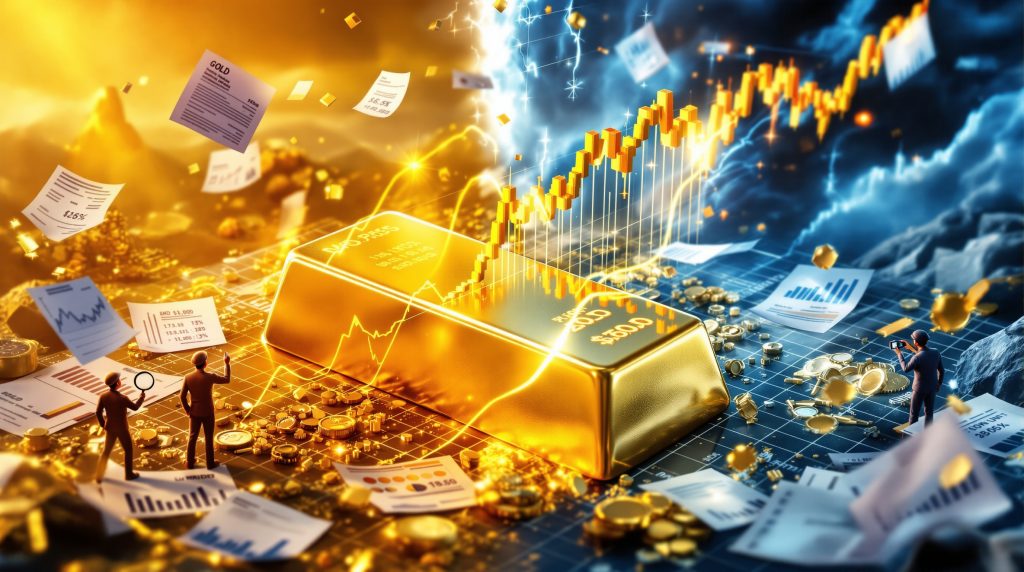Magical Thinking in Precious Metals: When Emotion Trumps Economic Reality
How does magical thinking influence investment decisions in precious metals markets? This psychological phenomenon leads investors to form beliefs that contradict economic fundamentals, historical patterns, and market realities. From gold's meteoric rise toward $4,000 to silver approaching its historical highs near $50, understanding the psychology behind these markets has never been more important.
How Does Magical Thinking Influence Precious Metals Markets?
Magical thinking in precious metals markets occurs when investors develop beliefs that defy economic fundamentals and market realities. This psychological phenomenon leads people to expect extraordinary price movements based on emotion rather than evidence, creating market distortions and potentially costly investment mistakes.
Research published in the Journal of Behavioral Finance shows that confirmation bias in investment decisions leads to selective information processing, where investors give greater weight to information confirming their existing beliefs while dismissing contradictory evidence.
Nobel laureate Robert Shiller has extensively documented how "narrative economics" can drive market movements, often detaching prices from fundamental values. His research demonstrates how compelling stories can override rational analysis, particularly in commodity markets with cultural and historical significance.
Understanding the Psychology Behind Precious Metals Investing
Behavioral economics identifies several cognitive biases affecting precious metals investors:
- Confirmation bias: Investors actively seek information supporting their existing beliefs about price movements while ignoring contradictory evidence
- Narrative fallacies: Creating compelling stories to justify price expectations that contradict market fundamentals
- Recency bias: Overweighting recent price movements when forecasting future trends
- Hindsight bias: Believing past market events were more predictable than they actually were
- Emotional decision-making: Fear, greed, and anxiety driving investment choices rather than rational analysis
- Historical amnesia: Forgetting or dismissing previous market corrections and their causes
- Anchoring: Over-relying on initial information (such as historical price highs) when making decisions
These psychological factors help explain why precious metals markets frequently disconnect from fundamental supply-demand dynamics.
What's Driving Current Precious Metals Price Movements?
Gold's Record-Breaking Performance
Gold has reached unprecedented price levels, approaching $4,000 per ounce. This remarkable performance is supported by legitimate economic and geopolitical factors:
- Global political uncertainties creating safe-haven demand
- Economic instability concerns, particularly around sovereign debt levels
- Central bank monetary policies maintaining low real interest rates
- Ongoing investor demand from both retail and institutional sectors
According to World Gold Council research, gold prices respond to a framework of factors including:
- Opportunity cost (interest rates and bond yields)
- Market uncertainty (volatility and geopolitical risk)
- Momentum (technical trading patterns)
- Wealth effect (income growth in emerging markets)
Academic research published in the Financial Analysts Journal shows gold exhibits low correlation with equities and bonds over extended periods, supporting its role as a portfolio diversifier during financial stress. The record high gold prices we're currently witnessing reflect both real economic concerns and speculative positioning.
Silver's Volatile Journey Toward Previous Highs
Silver has approached $48 per ounce in recent trading, nearing its previous historical peaks. To understand what might happen next, consider silver's price history:
- Pre-1979: Trading below $5 per ounce
- January 1980: Brief spike to approximately $37 monthly average (intraday high near $50)
- Driven by the Hunt brothers' attempt to corner the silver market
- Followed by a dramatic price collapse
- 1980-2005: Approximately 14 years below $5.50 per ounce
- April 2011: Second spike to approximately $49.82 before sharp correction
- Current: Approaching previous highs again
According to the Silver Institute, approximately 50% of silver demand comes from industrial applications, making it more sensitive to economic growth expectations than gold. This dual nature as both precious metal and industrial commodity creates unique price dynamics. Some analysts point to a potential silver market squeeze as a contributing factor to recent price movements.
Platinum and Palladium Market Dynamics
Platinum prices have exceeded $1,600 per ounce, driven primarily by:
- Marketing efforts and speculative investment positioning
- Inventory building by industrial users
- Supply constraints from South African production
According to Johnson Matthey's PGM Market Report, South African platinum group metals production faces ongoing challenges including:
- Aging infrastructure at deep-level mines
- Power supply disruptions from Eskom (South African utility)
- Labor cost pressures
- Declining ore grades at mature operations
Palladium has shown less dramatic price movements, with trading patterns suggesting potential return to the $1,200 range when commercial interests prevail over speculative positioning.
Why Do Investors Abandon Economic Reality?
The Allure of Narrative Over Numbers
Investors sometimes develop beliefs that prices will rise indefinitely despite:
- Historical precedents of corrections
- Economic laws of supply and demand
- Physical production realities
- Geological constraints
This phenomenon reflects what behavioral economists call "escalation of commitment" – increasing investment in a failing course of action to justify previous decisions. In precious metals markets, this often manifests as doubling down on bullish positions despite mounting contradictory evidence.
Standard economic theory demonstrates that higher commodity prices incentivize both:
- Increased exploration and production from higher-cost deposits
- Demand destruction through substitution and conservation
This fundamental relationship creates natural price-limiting mechanisms over the medium to long term. Comprehensive precious metals analysis suggests that these economic realities eventually reassert themselves after speculative phases.
The Evolution of Magical Narratives
When one narrative fails to materialize, investors often pivot to new justifications:
| Time Period | Debunked Narrative | Reality Check |
|---|---|---|
| 4 Years Ago | "Plunging ore grades mean we're running out of silver" | USGS data shows minable reserves now at record levels |
| 2021 | "Silver above-ground inventories are disappearing" | COMEX and LBMA inventories at record levels |
| Current | "Solar power will consume all available silver" | Silver Institute data shows solar uses ~14% of annual supply |
The "peak silver" theory has been consistently refuted. According to the U.S. Geological Survey, global silver reserves have increased from 520,000 metric tons in 2014 to 570,000 metric tons in 2024, despite continued mining production.
Research by mining economist Phillip Crowson explains how the "marginal cost curve" in mining creates supply elasticity:
- At low prices, only low-cost deposits are profitable
- As prices rise, progressively higher-cost deposits become economically viable
- This creates a natural supply response over time
The Central Bank Purchasing Myth
Reality of central bank gold purchases:
- 2022: Approximately 11 million ounces (net)
- 2023: Approximately 14.6 million ounces (net)
- 2024 (through July, annualized): Approximately 7.3 million ounces
Some market narratives claim central banks are secretly buying 3-4 times more gold than reported. This is implausible because:
- International central bank agreements require transparent reporting of monetary reserves
- Central banks generally adhere to these regulations
- Central banks serve multiple roles in gold markets beyond reserve accumulation:
- Acting as national market makers
- Managing sovereign wealth fund transactions
- Facilitating mint operations
- Conducting monetary policy operations
How Does Silver Exemplify Magical Market Thinking?
Historical Price Patterns and Their Lessons
Silver's price history reveals important cyclical patterns that investors should consider:
- Two previous approaches to the $50 level (1980 and 2011)
- Both instances followed by significant corrections
- Extended periods of lower prices between price spikes
- Supply and demand fundamentals reasserting themselves after speculative phases
These patterns demonstrate how market forces eventually correct prices that move too far from economic reality. Understanding the gold-silver ratio insights can provide valuable perspective on relative valuation between these metals.
The "This Time Is Different" Fallacy
Current magical thinking includes the belief that once silver breaks $50, it will immediately surge to $100. This narrative ignores:
- Historical precedent: Previous breaches of the $50 level followed by significant corrections
- Economic realities that challenge the "this time is different" narrative:
- Supply elasticity: Higher prices stimulate increased production
- Demand elasticity: Higher prices reduce consumption in price-sensitive applications
- Investor profit-taking: Psychological price barriers often trigger selling
- Substitution effects: Manufacturers finding alternatives to expensive materials
As economist John Kenneth Galbraith famously noted: "The specious cry of 'this time is different' has been heard before every major market correction in history."
What's the Reality Behind Silver Supply and Demand?
Supply Fundamentals Contradict Shortage Narratives
According to the U.S. Geological Survey and industry sources:
- Above-ground inventories at record levels according to COMEX and LBMA data
- Minable reserves at record levels and expanding
- Higher prices (approaching $50 vs. previous $15) incentivizing:
- Increased exploration
- Development of previously marginal deposits
- Expansion of existing mining operations
The U.S. Geological Survey reports that global silver mine production runs approximately 26,000 metric tons (835 million troy ounces) annually, with leading producers including Mexico, China, Peru, Chile, and Australia.
Additionally, recycled silver contributes approximately 180-200 million ounces annually to global supply, according to the Silver Institute. This comes primarily from industrial applications, jewelry, and silverware.
Fabrication Demand Responds to Price Changes
According to data from the World Silver Survey:
- Jewelry and silverware demand declining globally, especially in India and China
- Higher prices leading to:
- Reduced metal content in manufactured items
- Fewer consumer purchases due to affordability concerns
- Substitution with alternative materials
Research published in Resources Policy demonstrates that while short-run industrial demand for metals is relatively inelastic (users cannot immediately substitute), long-run demand becomes more elastic as manufacturers find alternatives or reduce usage per unit of production.
Is Solar Power Really Driving Silver To New Heights?
Understanding the Solar Panel Manufacturing Reality
Recent surge in Chinese solar panel exports represents:
- Inventory liquidation rather than sustained production increase
- Response to potential trade restrictions and tariffs
- Attempt to address domestic overcapacity issues
According to industry analyses, Chinese solar panel manufacturers expanded capacity significantly in 2022-2023, leading to:
- Excess production capacity globally
- Declining panel prices
- Industry operating at approximately 40% capacity utilization
Long-Term Solar Silver Demand Projections
The International Energy Agency reports:
- 2023: Approximately 410 GW of new solar photovoltaic capacity added globally
- Solar PV is the fastest-growing electricity generation technology
- Costs have declined approximately 90% over the past decade
While solar power generation will continue growing due to cost advantages over alternatives, technological improvements continue to reduce silver requirements:
- Average silver content per solar panel has decreased from approximately 400-450 mg per cell in 2007 to approximately 65-75 mg per cell today
- Research by the Fraunhofer Institute documents ongoing innovations reducing silver consumption:
- Thinner busbars and fingers in cell design
- Copper-plated metallization reducing silver requirements
- Alternative conductive materials under development
- Improved screen printing techniques reducing waste
Additionally, as the first generation of solar panels reaches end-of-life (typical lifespan 25-30 years), silver recovery from recycling will become increasingly significant. The International Renewable Energy Agency (IRENA) projects cumulative end-of-life panel waste reaching 8 million metric tons by 2030, with silver recovery rates from recycled panels potentially exceeding 90%.
How Are Automotive Trends Affecting Precious Metals Markets?
Platinum Group Metals and Vehicle Production
Some market narratives suggest mass abandonment of electric vehicles driving platinum group metals demand. However, official statistics tell a different story:
- Global automotive production showing modest growth, not dramatic increases
- China (largest market):
- Total production approximately 30.2 million vehicles in 2023
- New energy vehicles (EVs and plug-in hybrids) representing 37.6% of production
- Gradual shift toward hybrid vehicles incorporating some platinum group metals
- United States (second largest market at ~16 million vehicles annually):
- Electric vehicle market share still growing despite slowing adoption rate
- No evidence of mass return to conventional vehicles
According to automotive industry research, catalytic converters in conventional vehicles contain varying amounts of platinum group metals:
- Gasoline vehicles: Primarily palladium (1.5-3.0 grams per vehicle) with some rhodium
- Diesel vehicles: Higher platinum content (3-7 grams per vehicle)
- Hybrid vehicles: Reduced but still significant PGM content
- Battery electric vehicles: No PGMs in emissions systems
Investment Implications for Platinum and Palladium
Current price levels largely reflect speculative positioning rather than fundamental demand shifts. Market participants should consider:
- Technological substitution between platinum and palladium based on relative prices
- Emissions regulatory trends in major markets
- Production constraints in South Africa and Russia (primary producers)
- Recycling rates increasing as catalyst collection systems mature
Long-term outlook suggests return to historical trading ranges as markets adjust to actual fabrication demand rather than narrative-driven speculative positioning.
How Can Investors Avoid Magical Thinking Traps?
Developing a Rational Investment Approach
To avoid costly magical thinking traps, consider these approaches:
- Challenge assumptions and seek contrary evidence
- Understand the difference between short-term price movements and long-term value
- Recognize that economic laws still apply to precious metals markets
- Consider profit-taking at historical resistance levels
- Maintain perspective on the cyclical nature of commodity markets
As behavioral economist Daniel Kahneman advises in his book "Thinking, Fast and Slow," investors should develop systematic processes to overcome natural cognitive biases. Current gold price forecasts should be evaluated critically against both supporting and contradictory evidence.
The Value of Fundamental Analysis
Successful precious metals investing requires:
- Tracking actual supply and demand metrics rather than market narratives
- Considering production costs as a floor for sustainable prices
- Monitoring fabrication demand across multiple sectors
- Recognizing the impact of investor sentiment on short-term price movements
- Understanding how price elasticity affects both supply and demand
While technical analysis has its place in timing entry and exit points, fundamental analysis provides the foundation for understanding likely price ranges over medium and long-term horizons. As Forbes explains, retail investor sentiment can drive significant short-term price movements, but sustainable trends ultimately depend on fundamental factors.
What Does History Tell Us About Precious Metals Price Sustainability?
Lessons From Previous Market Cycles
Precious metals prices can remain elevated for extended periods when supported by fundamentals. However, prices that rise primarily due to investment demand rather than fabrication demand tend to be less stable.
Economic realities eventually reassert themselves through:
- Increased production from both existing and new sources
- Reduced consumption through efficiency and substitution
- Technological innovation finding alternatives
- Investor profit-taking at psychological price barriers
The Danger of "This Time Is Different" Thinking
Similar narratives have appeared in previous market cycles:
- 1979: "The $58 billion deficit is unsustainable"
- 1979: "The nearly $1 trillion national debt will collapse the Treasury market"
- 2021: "Silver supplies are about to be exhausted"
Each time, markets eventually returned to fundamental valuation ranges. While circumstances evolve and each cycle has unique characteristics, the fundamental economic principles governing commodity markets remain remarkably consistent. According to Kinesis Money, understanding the psychology behind precious metals investing is crucial for making rational decisions in these emotionally charged markets.
FAQs About Precious Metals Markets
Will Gold Continue Rising Past $4,000?
While gold has legitimate support from economic and geopolitical factors, investors should remain cautious about extrapolating recent gains indefinitely. Price corrections are normal even in strong bull markets, and profit-taking could emerge at psychological price barriers. The World Gold Council's research framework suggests monitoring opportunity costs (interest rates), market uncertainty, momentum factors, and global wealth trends to gauge potential price direction.
Why Haven't Previous Silver Price Predictions of $100+ Materialized?
These predictions typically ignore economic realities like supply elasticity, demand destruction at higher prices, and investor behavior patterns. When prices rise dramatically, both production increases and consumption decreases, creating natural market balancing mechanisms. According to the Silver Institute, the market responded to previous price spikes with both increased mine supply and reduced fabrication demand.
Are Central Banks Secretly Accumulating More Gold Than Reported?
This narrative contradicts international central bank agreements requiring transparent reporting of monetary reserves. Central banks generally adhere to these regulations, and their gold market activities extend beyond simply accumulating reserves. Data from the World Gold Council and international financial institutions shows no evidence supporting claims of unreported large-scale acquisition.
Will Solar Panel Manufacturing Consume All Available Silver?
No. While solar power generation continues growing, technological improvements reduce silver content per panel, and the industry adjusts to price changes through material efficiency and substitution. According to the Silver Institute, solar panel manufacturing currently uses approximately 140 million ounces of silver annually, representing about 14% of total global silver supply of approximately 1 billion ounces.
Are Electric Vehicles Being Abandoned in Favor of Conventional Vehicles?
The data doesn't support this narrative. While electric vehicle growth has slowed in some markets, they continue gaining market share globally. According to the China Association of Automobile Manufacturers, new energy vehicles represented 37.6% of Chinese vehicle production in recent data, with the trend continuing upward, though at a more measured pace than in previous years.
Further Exploration
Readers interested in learning more about precious metals market analysis can explore educational content from industry organizations like the World Gold Council, Silver Institute, and various financial education platforms that offer regular market commentary and insights on precious metals trends.
Disclaimer: The information provided in this article is for educational purposes only and should not be considered investment advice. Precious metals markets involve significant risks, and past performance is not indicative of future results. Consult with a qualified financial advisor before making investment decisions.
Want to Catch the Next Major Mineral Discovery Before the Market Does?
Stay ahead of the market with Discovery Alert's proprietary Discovery IQ model that delivers real-time notifications on significant ASX mineral discoveries, turning complex data into actionable investment insights. Explore historic examples of exceptional discovery returns by visiting Discovery Alert's dedicated discoveries page and begin your 30-day free trial today.




